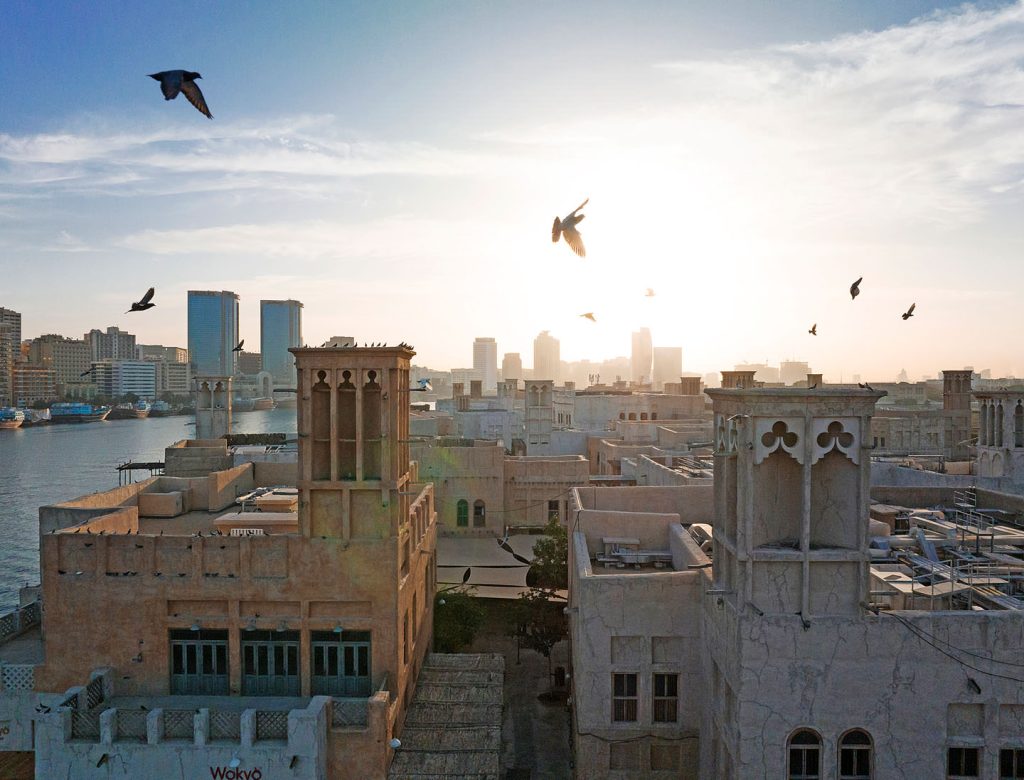Have you ever imagined how people kept cool in the Arabian Gulf before modern HVAC systems? In old Dubai neighborhoods, wind tower houses—or barjeel—tell that very story. These elegant structures aren’t just architectural landmarks; they represent innovation, climate adaptation, and cultural legacy. Visiting them today offers a glimpse into Dubai’s quieter past, where coral stone walls, gypsum plaster, and hand-carved wooden beams shaped daily life. Most are preserved in historical districts like Al Fahidi and Al Shindagha, and exploring them is like stepping into another century without leaving the city.
Begin your visit in Al Fahidi Historical Neighbourhood near Dubai Creek
Al Fahidi is the city’s most accessible gateway into traditional Emirati architecture. Located on the edge of Dubai Creek, this heritage district preserves dozens of restored wind tower houses. Each alley tells a story through its irregular paths, thick-walled courtyards, and rooftop towers that captured wind from every angle. Several towers here have been converted into museums, art spaces, or cultural centers. The Sheikh Mohammed bin Rashid Al Maktoum Centre for Cultural Understanding operates within one such house, offering guided tours that explain not only the structure but the customs tied to it. Visitors can touch the materials, sit in shaded courtyards, and observe how airflow once cooled these homes naturally.
Al Shindagha Museum provides a curated experience of domestic history
Just across the Creek, Al Shindagha has undergone extensive restoration. It is now home to one of Dubai’s largest heritage preservation projects, and wind tower houses play a central role. The Al Shindagha Museum hosts exhibits in former homes, each featuring a traditional tower. Some focus on domestic life, others on trade, perfumery, or navigation. What makes this site unique is its narrative approach: rather than just preserving walls, the museum tells stories through interactive displays, soundscapes, and even cooking demonstrations. The towers are left mostly untouched in structure but enhanced with historical insights. This makes Al Shindagha ideal for first-time visitors who want history presented with clarity and detail.
Timing your visit during winter months makes the experience far more comfortable
Dubai’s heat can make daytime walks difficult during summer, and wind towers, though ingenious, can’t offset modern temperatures. For this reason, visiting from October to April is ideal. Early mornings and late afternoons are the best times to explore without facing harsh sun exposure. During the winter, several heritage festivals are also held in these districts, such as Sikka Art Festival or the UAE’s National Day events, adding extra cultural layers. Some houses host pop-up exhibits, poetry readings, or traditional craft sessions during these times. Planning around these dates can turn a simple visit into a richer cultural outing.
Look closely at the towers—they differ in shape, materials, and purpose
Not all wind towers are the same. Some were purely functional, channeling breeze down into living rooms using a system of internal wooden slats. Others served symbolic or aesthetic roles, especially in larger homes owned by merchants. The towers vary in height and shape depending on the original owner’s wealth, social status, and even the location of the home within the district. In Al Fahidi, most towers are square and made with gypsum and coral stone, while in Shindagha, you might notice more decorative plasterwork. Observing these differences adds nuance to your visit and helps you appreciate the architectural choices of the past.

Many wind tower houses have become cultural centers or artist studios
Preservation in Dubai doesn’t mean freezing buildings in time—it often means reimagining their use. Several wind tower homes now operate as art galleries, calligraphy studios, or craft hubs. One house might offer a traditional Emirati cooking class, while another may host storytelling evenings in its central majlis. This modern reuse keeps the spaces alive and relevant, particularly among young creatives and cultural tourists. The synergy between old architecture and contemporary culture makes these visits memorable and layered. You’ll find yourself admiring 19th-century cooling techniques while sipping Arabic coffee brewed with saffron and cardamom.
You can join guided tours or wander self-paced with printed maps
Both Al Fahidi and Al Shindagha offer free or paid access, depending on the site and exhibition. Some locations require pre-booking, especially if part of a tour group or cultural program. However, most allow casual, self-guided exploration. Visitor centers in both areas provide brochures with maps highlighting major wind towers, exhibition rooms, and rest areas. Guided tours, typically available in English and Arabic, add depth with stories about the families who lived there and the historical context of their homes. These sessions often last 45–90 minutes and include access to otherwise closed rooftops or tower interiors.
Photography is encouraged but with respect for cultural guidelines
Taking pictures of the architecture is welcomed, and many wind tower houses make for stunning photo backdrops. Early mornings offer soft light and fewer crowds, ideal for capturing the earthy tones of coral stone against blue skies. However, in functioning cultural centers or private galleries, always ask permission before photographing people or artworks. Modesty is also key—although these are heritage sites, they are tied closely to Emirati identity and values. Wearing respectful clothing and being aware of others around you ensures a more harmonious visit.
Getting there is simple using Dubai’s metro, buses, or abras
Al Fahidi Historical District is easily accessible via the Al Fahidi Metro Station on the Green Line, just a short walk from the entrance. For Al Shindagha, the nearest station is Al Ghubaiba, and from there it’s a 10-minute walk. If you’re near Deira or the Gold Souk, you can cross the Creek on a traditional wooden abra for a small fee, arriving directly at the entrance to Al Shindagha. This method not only saves time but adds charm to the visit. Public buses and taxis are also available, but nothing beats arriving by water as people did a century ago.
These wind tower homes show a Dubai few tourists ever imagine
Behind the shine of glass towers and supercars lies a different Dubai—one shaped by sea breezes, mud brick, and human ingenuity. Wind tower houses are not just historical structures; they are storytellers. Each plaster wall, wooden beam, and shaded courtyard speaks of resilience, adaptation, and beauty drawn from simplicity. Visiting these homes doesn’t just fill your camera roll—it deepens your understanding of the city’s roots, reminding us that even in the desert, design can be both functional and poetic.
This article was created by the editorial team at www.few.ae.


 then "Add to Home Screen"
then "Add to Home Screen"